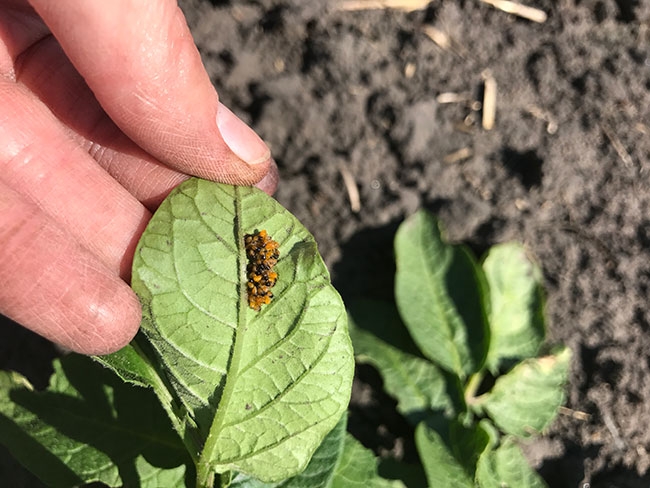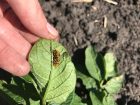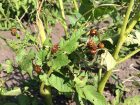
Features
Agronomy
Crop Protection
Colorado potato beetle management – without neonics
Ever since becoming widely used in Canada in the late 1990s, neonicotinoid pesticides have helped keep Colorado potato beetle (CPB) populations in check. But the pest could be poised for a comeback, due to growing CPB resistance to neonics and the prospect of the Group 4 insecticides being banned from Canadian potato farms.
March 12, 2018 By Mark Halsall
 Colorado potato beetle egg mass. Ever since becoming widely used in Canada in the late 1990s
Colorado potato beetle egg mass. Ever since becoming widely used in Canada in the late 1990sHeath Canada’s Pest Management Regulatory Agency (PMRA) proposed a ban on imidacloprid (the first neonicotinoid to be registered for CPB control) in November 2016, and plans to release a final decision in December of this year on whether to phase out the popular pesticide used to control insect pests in a wide range of crops. The PMRA has also reviewed the use of two other neonic products, thiamethoxam and clothianidin, and proposed a ban for some crops, while limiting its uses on others. The final decision is also expected to be released in December 2018, according to the government of Canada’s website.
Ian Scott, a research scientist with Agriculture and Agri-Food Canada (AAFC) based in London, Ont., says the loss of neonicotinoid chemicals would be deeply felt.
“It definitely would have an impact on potato pest management. [It’s] been a very valuable class of insecticides to potato growers, so anytime you lose something like that there’s going to be impact until other solutions are found,” he says.
Scott’s research has included monitoring CPB populations in different parts of the country for neonicotinoid resistance and cross-resistance with other insecticides. He, along with two other AAFC scientists and the Canadian Horticultural Council, have put together a proposal for a five-year, Canadian Agricultural Partnership-funded project that would further CPB resistance work and assess new management options for controlling the beetles.
“Part of what’s been driving this work is the fact that there is concern over what’s going to happen with the neonic products. Whether or not there’s going to be reductions [in use] or complete removal of these products, we don’t know at this point,” Scott says. “I think that’s one of the things that growers would like to see going forward – what are the alternatives, how can we work with the products that are going to be available if the neonics are not?”
According to Tracy Shinners-Carnelley, vice-president, research and quality enhancement for Manitoba’s Peak of the Market, there really isn’t very much in the way of effective replacements for neonics – at least not yet.
“The regulatory challenges that these chemistries are facing means the industry has no choice but to rethink how we manage CPB,” she says. “The dilemma is, you need to have other effective chemistries to be able to use if you walk away from using neonics. We really don’t have a lot of those options.”
Foliar insecticide
Shinners-Carnelley says a study led by Peak of the Market has been evaluating management strategies to control resistant CPB populations. The three-year research project wraps up this year, and has assessed different combinations of seed treatments, in-furrow and foliar insecticides.
One non-neonicotinoid insecticide that showed good control in the study was the foliar insecticide Delegate. “It performed very, very well,” Shinners-Carnelley says, “but we need to make sure that it is used wisely so we maintain it into the future as an excellent chemistry.”
“History has clearly shown that CPB can develop resistance to every chemistry that is thrown at it – it’s just a matter of time. So, we really need to make sure that we’re only using these newer classes of chemistry when they are needed because we need to keep them effective as long as we can,” she says
A key part of this stewardship may mean having to revisit and validate economic thresholds for applying foliar insecticides – and potato farmers having to get accustomed to seeing many more beetles in their fields.
“Growers have in many cases forgotten what it’s like to have to manage CPB with foliar insecticides, because when the neonics were first introduced and for many years after that, they worked exceptionally well. For the most part, they controlled that pest to the point where growers never really had to worry about tolerating a measurable number of beetles in a field or monitoring defoliation,” Shinners-Carnelley says. “It’s a very uncomfortable feeling for growers to go out and scout and see their plants being chewed on or see patches of the field that have a high infestation of beetles.”
Shinners-Carnelley adds that when developing thresholds, different factors such as the number of beetles, the amount of defoliation, the type of potato variety, crop maturity and the length of season all need to be taken into account. “All these things are variable so one threshold is not going to apply to everything.”
Field trials conducted during Shinners-Carnelley’s research study indicate that despite growing CPB tolerance to neonicotinoids, the chemicals still have an important place.
“It goes against best practice but the recommendations I’ve been using based out of this this trial are that in the short-term, growers need to be using the highest labelled rate of the products so that they’re getting the longest duration of control,” she says.
“We have very few other chemistries, so yes in an ideal world where we had multiple classes of effective insecticides the recommendation would be simple. It would be ‘don’t use neonics, go and use another class of chemistry.’ But we just don’t have those one-for-one alternatives.”
Scott is hopeful that more viable alternatives to neonicotinoids will eventually be developed. “I think the industry is very innovative in its approach to all aspects of potato production and pest management, and I know it’s always looking within Canada and outside for other solutions,” he says.
Integrated pest management
For now, Scott believes integrated pest management (IPM) is a grower’s best bet for CPB protection. A combination of chemical and cultural techniques, he says, will help slow resistance development and also prolong the effectiveness of current CPB insecticides.
Scott points to crop scouting as important tool for potato farmers. “I think the more monitoring the growers can do, the earlier that they can diagnose a problem in the field before it gets out of hand,” he says.
Scott recommends producers rotate chemical classes in season if possible and also try not spray insecticides too often, since this also kills predators that help keep CPB populations down by feeding on the insect’s eggs and the early stages of the beetle. Other non-chemical strategies for CPB control listed by Scott include crop rotation and varying the timing for planting potato crops.
Scott notes that maintaining field borders can also help reduce the spread of CPB populations. He says buffer zones around potato fields can provide more habitat for CPB predators, and can also act as a physical barrier for the beetles.
Shinners-Carnelley says IPM is always a good idea when it comes to insect control. But she cautions that some recommended practices such as buffer zones and crop rotation aren’t always practical when it comes to a bug like CPB, since it isn’t soilborne and can easily fly between fields.
Print this page



